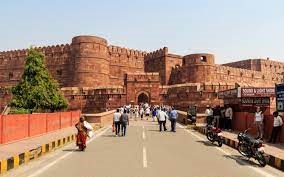Description

Disclaimer: Copyright infringement not intended.
Context
- Archaeological Survey of India, under Ministry of Culture, has no information about modifications of this fort during Akbar rule.
- It also does not have any information on architect and ruler who constructed Agra fort, response to an RTI reveals.
- Indian Navy will commemorate the 130 years of this struggle at the same place.
History
- Agra fort. Also known as Agra Red Fort, is a world heritage site and one of the major touring attraction in India.
- As per some historians it is a successor of the 11th century, a fort named Badalgarh which was built by Rajputs of the Sikarwar dynasty.
- Later this fort was captured, renovated and used by Sikandar Lodi and his son Ibrahim Lodi as centre of power.
- After first Battle of Panipat in 1526, Babur took control of this fort and later Mughal king Humayun was crowned as the second Mughal emperor here.
- This was captured by Sher Shah suri from Humayun but was taken back by the Mughals after death of Sher Shah suri.
- Hence Akbar, while declare Agra his capital, is believed to reconstruct Badalgarh in its present form of Agra fort.
Details of Agra Fort
- Lying parallel to right bank of river Yamuna It covers an area of 94-acre and has a semicircular plan.
- There are four gates, including Delhi Gate and Lahore Gate, present in all Four sides of this fort.
- It is situated in the city of Agra in Uttar Pradesh.
- It is made in the Mughal style of architecture and the use of Red sandstone (brought from Rajasthan) and marble is extensive
- The fort is surrounded by a 21.4 m high fortification wall.
- Compare to the 5000 buildings recorded by court historian of Akbar, there exist only about two dozens of monuments in the Fort today.It includes Jahangir Palace, Babur’s Baoli, Nagina Masjid, Diwan-I-Am.
- It also houses the Pearl Mosque or Moti Masjid, mde of white marble. is built by Shah Jahan.
- It also includes a hall Diwan-i-Khas was used to keep Peacock Throne and to receive state’s special guests in the Mughal times.
- The main palaces in this fort include Macchi Bhavan, Khas Mahal and Shah Jahani Mahal.

World heritage site
- World Heritage site, any of various areas or objects inscribed on the United Nations Educational, Scientific and Cultural Organization (UNESCO) World Heritage List.
- The sites are designated as having “outstanding universal value” under the Convention Concerning the Protection of the World Cultural and Natural Heritage.
-
- There are three types of sites: cultural, natural, and mixed.
World Heritage sites in India
Cultural (32)
- Agra Fort (1983)
- Ajanta Caves (1983)
- Archaeological Site of Nalanda Mahavihara at Nalanda, Bihar (2016)
- Buddhist Monuments at Sanchi (1989)
- Champaner-Pavagadh Archaeological Park (2004)
- Chhatrapati Shivaji Terminus (formerly Victoria Terminus) (2004)
- Churches and Convents of Goa (1986)
- Dholavira: a Harappan City (2021)
- Elephanta Caves (1987)
- Ellora Caves (1983)
- Fatehpur Sikri (1986)
- Great Living Chola Temples (1987, 2004)
- Group of Monuments at Hampi (1986)
- Group of Monuments at Mahabalipuram (1984)
- Group of Monuments at Pattadakal (1987)
- Hill Forts of Rajasthan (2013)
- Historic City of Ahmadabad (2017)
- Humayun's Tomb, Delhi (1993)
- Jaipur City, Rajasthan (2019)
- Kakatiya Rudreshwara (Ramappa) Temple, Telangana (2021)
- Khajuraho Group of Monuments (1986)
- Mahabodhi Temple Complex at Bodh Gaya (2002)
- Mountain Railways of India (1999, 2005, 2008)
- Qutb Minar and its Monuments, Delhi (1993)
- Rani-ki-Vav (the Queen’s Stepwell) at Patan, Gujarat (2014)
- Red Fort Complex (2007)
- Rock Shelters of Bhimbetka (2003)
- Sun Temple, Konârak (1984)
- Taj Mahal (1983)
- The Architectural Work of Le Corbusier, an Outstanding Contribution to the Modern Movement (2016)
- The Jantar Mantar, Jaipur (2010)
- Victorian Gothic and Art Deco Ensembles of Mumbai (2018)
Natural (7)
- Great Himalayan National Park Conservation Area (2014)
- Kaziranga National Park (1985)
- Keoladeo National Park (1985)
- Manas Wildlife Sanctuary (1985)
- Nanda Devi and Valley of Flowers National Parks (1988, 2005)
- Sundarbans National Park (1987)
- Western Ghats (2012)
Mixed (1)
- Khangchendzonga National Park (2016)

Archaeological Survey of India (ASI)
- The Archaeological Survey of India (ASI) comes under the Ministry of Culture. It is an organization dedicated for the archaeological researches.
- It also works to protect the cultural heritage of the nation. The work includes Maintenance of ancient monuments and archaeological sites.
- It regulates all related as per the provisions of the Ancient Monuments and Archaeological Sites and Remains Act, 1958.
- It also regulates Antiquities and Art Treasure Act, 1972.
|
PRACTICE QUESTION
By highlighting the role of ASI in the protection of Agra Red Fort, an architecture marvel, Explain the concept of World heritage sites. (250 words)
|
https://www.indiatoday.in/india/story/asi-does-not-know-built-agra-fort-2388907-2023-06-05







